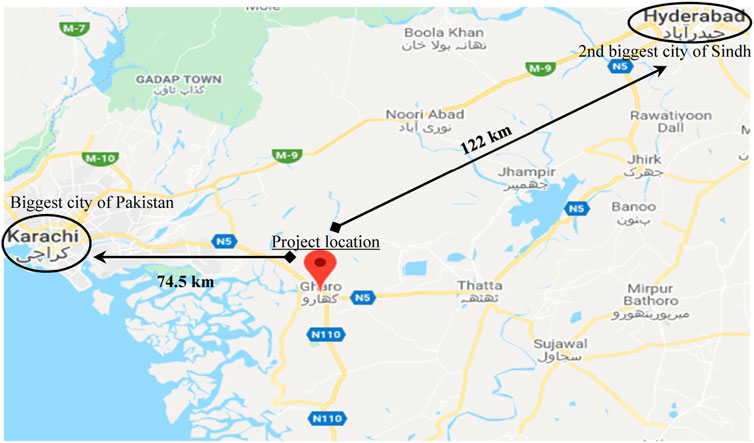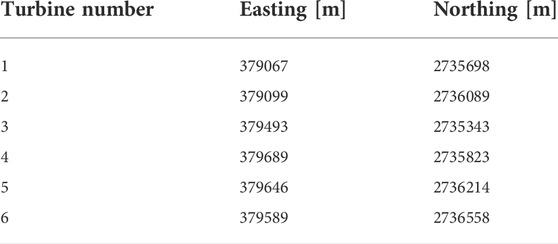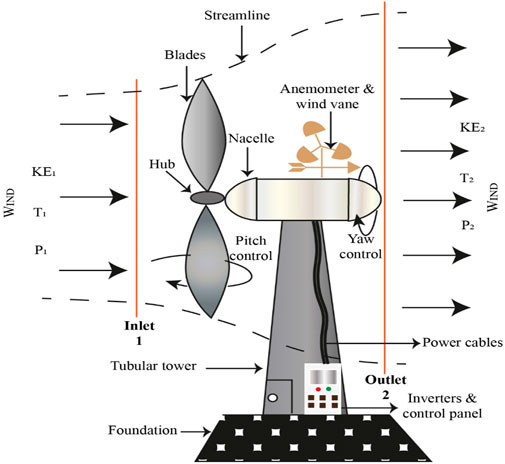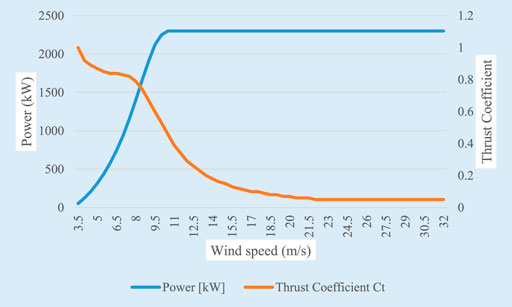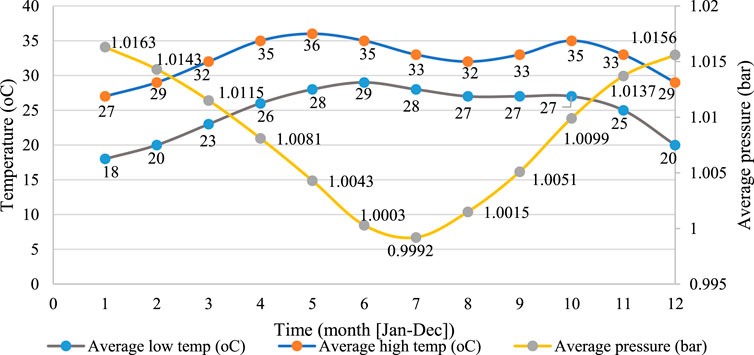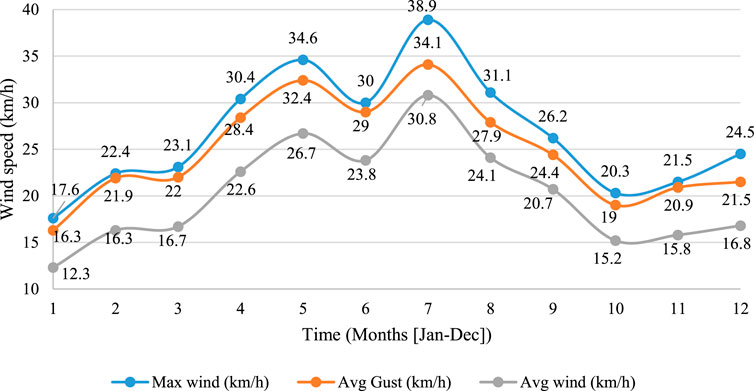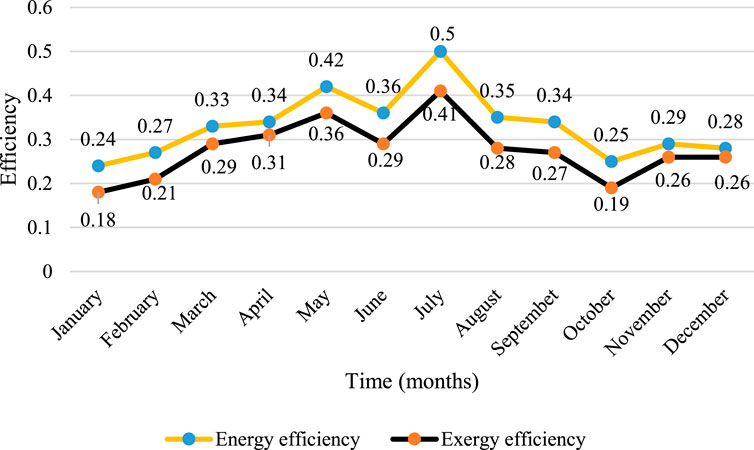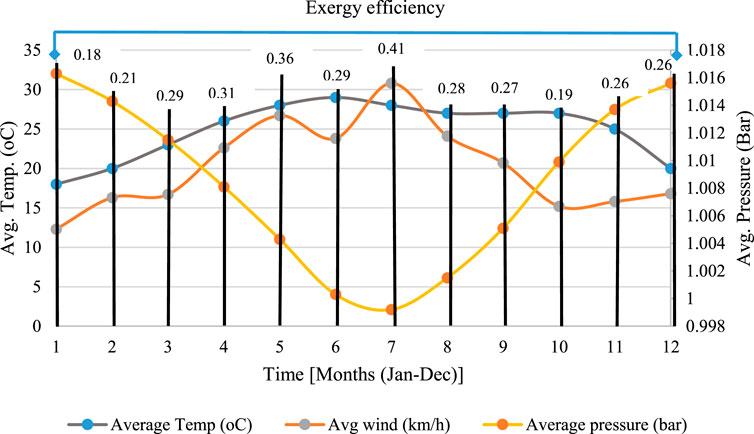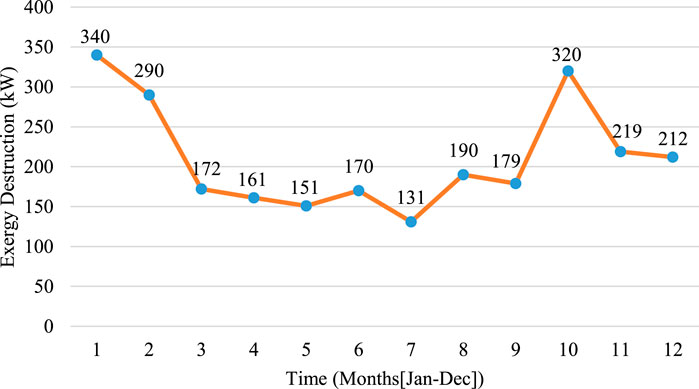- 1School of Electric Power, South China University of Technology, Guangzhou, China
- 2School of Physics and Optoelectronics, South China University of Technology, Guangzhou, China
- 3Department of Electrical Engineering, The University of Lahore, Lahore, Pakistan
Sustainable, inexhaustible, economical, and clean energy has become a vital prerequisite to replace fossil fuel sources for power production. In such a context, countries like Pakistan, which are heavily skewed towards fossil fuel-fired plants, are diverting attention to install more and more indigenous renewable energy sources projects such as solar-photovoltaic and wind turbine power plants. In order to harness the maximum energy of wind turbines, it is crucial to factually and precisely assess system performance, which is traditionally inferred by energy analysis (first law analysis). Nevertheless, this analysis only computes the nominal power generation output and ignores the effect of meteorological variables that can lead to some serious errors during the energy planning phase. Consequently, this case study presents both the energy and exergy analysis of a wind farm located in Gharo town of Thatta District along the coastline of the Indus Delta. Energy analysis is carried out to quantify energy efficiency, while exergy analysis computes exergy efficiency by taking into account the effect of pressure, temperature, and wind speed. Comparisons of both efficiencies are provided, and the result substantiates that exergy efficiency turns out to be lower than energy efficiency. However, exergy is a more viable index due to the inclusion of exergy destruction, and in comparison to the energy indicator, it presents the actual performance of a thermodynamic system. The monthly energy and exergy efficiency of the general electric wind turbines are maximum in July having values of 0.5 and 0.41, respectively.
1 Introduction
The tremendous increase in energy demands due to extensive population growth, technological development, and industrialization is primarily met by prevalent fossil fuel sources (Rapier, 2020; Tahir and Haoyong, 2020). Recently, the atmosphere is witnessing worse global warming because of over-reliance on these finite and polluted fossil fuel sources (Tahir et al., 2020; Welsby et al., 2021). In order to meet energy demands with minimal detrimental environmental impact, researchers are heading toward renewable energy source integration into the power grid (Alves et al., 2020; Tahir et al., 2021a). Amongst various renewable energy sources such as water, solar, and geothermal, wind energy utilization has increased manifolds due to its ease of availability, abundance, cost-competitiveness, and environmentally benign features (Wagner and Mathur, 2018; Tahir et al., 2019a).
Pakistan, being a third world country and the fifth most populated country in the world, is facing a demand-supply gap that led to several blackouts during the last decade (Tahir and Saqib, 2016). Similar to the rest of the world, Pakistan’s energy mix is heavily dependent on costlier thermal power plants, fired by imported fuel. Fuel import not only declines the foreign exchange reserves but also worsens climate issues. For that reason, the Pakistan government has established the Alternative Energy Development Board (AEDB) to improve the integration of renewable energy sources in a grid for reducing dependency on polluted finite fossil fuel sources. According to the renewable energy leap-forward development policy, AEDB issued letters of intent to various private and government companies to install renewable energy projects in the country. Two of the provinces (Sindh and Balochistan) are more suitable for wind turbine installation as these are closer to the coastline. At present, the Government entails painstaking attention to Sindh province as it is the second most populated province of the country and has plenty of vacant space available for wind farm projects. Furthermore, this province has suffered prolonged power outages and blackouts due to various reasons in the present electric grid infrastructure.
Most of the research activities regarding wind energy are about harnessing maximum energy (Minaeian et al., 2017; Abdolkhalig et al., 2018), overcoming stochastic nature (Yuan et al., 2014; Jabir et al., 2017), and cost and size optimization (Fetanat and Khorasaninejad, 2015; Johnston et al., 2015; Tahir et al., 2019b; Sun et al., 2020). Conversely, these studies do not present the accurate behavior of wind power generation because conventionally wind power systems use energy analysis. The energy analysis computes energy efficiency by nominal power generation, the ratio of energy generation to wind potential or in other words how much kinetic energy is converted to electricity. On the contrary, it ignores the prominent feature that wind speed/energy is dependent on many meteorological variables (such as temperature, pressure, air density, and humidity), and changes in wind speed due to these meteorological variables will result in different energy production. Hence, exergy analysis (also known as second law analysis) takes into account the effect of the above variables, wherein internal irreversibilities and external losses are included while assessing wind energy generation. Exergy is defined as the maximum work potential of a system when it comes to equilibrium with respect to the reference environment (Gaggioli, 1998; Tahir et al., 2021b; Tahir et al., 2022). Recently, exergy analysis has also been employed on other renewable energy technologies such as solar photovoltaic plants (Shukla et al., 2016a; Shukla et al., 2016b; Kumar et al., 2017) and biomass (Mehrpooya et al., 2018; Yang et al., 2020); however, wind energy power plants are gaining more attention due to its widespread usage and large capacity. A few of the most pertinent studies pertaining to second law analysis for wind energy systems are briefly elaborated below.
Horizontal and vertical axis wind turbine energy and exergy efficiency are evaluated by (Pope et al., 2010) for four different wind turbines such as NACA 63 (2)-215 Airfoil, FX 63-137 Airfoil, Savnious VAWT, and Zephyr VAWT. Subsequently, four different definitions of outlet velocity (V2) are outlined while efficiencies (energy and exergy) are computed by varying inlet velocity (V1) against four different V2. Ozgener et al. (Ozgener and Ozgener, 2007; Ozgener et al., 2009) concluded that exergy efficiency varies between 0 and 48.7% depending on wind speed while Jia et al. (Guang-Zheng et al., 2004) analyzed that exergy efficiency fluctuates between 35 and 45% when wind speeds are between 5 and 9 m/s.
In addition, meteorological variable effects on the exergy efficiency of wind turbines are contemplated in (Baskut et al., 2010). Baskut et al., (2011) employed exergy analysis on a wind farm in Turkey, wherein they pointed out that a decrease in the reference temperature results in considerable energetic and exegetic losses. However, for computing exergy efficiency, only the pressure differences between the inlet and outlet of wind turbines are taken into account while temperature and humidity differences are ignored. Exergy analysis of wind turbines for the location of Tehran is performed by Mehdi et al. (Ehyaei and Assad, 2021), which is given in the 13th chapter of book “Design and Performance Optimization of Renewable Energy Systems”, while Adel Mohammed Redha et al. (Redha et al., 2011) employed thermodynamic analysis (exergy analysis) for computing Sharjah-based VESTAS V52 wind turbine exergy efficiency for 3 months (January–March). Unlike Omer et al., it exploited the temperature differences but ignored the pressure and humidity differences when employing exergy analysis. Furthermore, Diyoke, (2020). investigated the exergy performance of wind turbines at four different sites in Nigeria, while Koroneos et al., (2003) investigated the exergy analysis of renewable energy sources including wind turbines, but wind speeds greater than 9 m/s are assumed as zero, which is not true in a practical world.
In a nutshell, most of the preliminary studies did not conduct a long term energy and exergy analysis as conducted by Baskut et al., (2011), which utilized 11-months data, while most of the aforementioned studies either used temperature differences or pressure differences when evaluating exergy efficiency. Herein, to fill this substantial and core pivotal gap, this study takes into account both the temperature and pressure differences for performing exergy analysis of the whole year. Afterward, pressure and temperature differences against the wind speed are exploited by observing the last 10 years (2009–2019) weather pattern. To the best of our best knowledge, this is the first time when energy and exergy analysis are carried out for any Pakistan location. This case study provides the technical characteristics of the wind farm installed in Gharo town, Sindh province (taken from the National Electric Power Regulatory Authority (NEPRA) (National Electric Power Regulatory Authority, 2021)) and observes meteorological variables (Online, 2021) to compute the wind speed of the year 2020. This study furthermore computes energy and exergy efficiency of wind turbine for a whole year, demonstrates the in-depth comparison of both efficiency, and finally, investigates the variation in exergy efficiency by varying temperature and pressure in an attempt to accurately assess the performance of the wind power plant at a given site. The limitations and assumptions used throughout this study are listed as follows.
i) Wind flow is assumed to be uni-dimensional, steady, and incompressible
ii) Temperature and pressure differences at the inlet and outlet of a wind turbine are taken into account
iii) Heat transfer or phase changes are not considered
iv) The effect of humidity is ignored
The rest of the article is structured as follows. Section 2 elaborates on the case study, and Section 3 provides an energy and exergy analysis investigation on the given case study. Section 4 demonstrates results and discussion, while significant findings summary and future work scope are given in Section 5.
2 Case study
The present case study of a 14 MW wind farm in the Gharo wind corridor, District Thatta, and province Sindh, is being installed by Burj Wind Energy Limited, a UAE-based company. Sindh province has a 290 km long coastline that makes it apt for wind power generation. Gharo (Latitude 24.7409° or 24° 44′ 27.2″ north, Longitude 67.581° or 67° 34′ 51.6″ east), a small town close to the coastline and not so far from the two biggest cities of Sindh province (Karachi and Hyderabad), is an ideal place for wind power plant generation. Wind farm location map and micrositting layout are shown in Figure 1 and Table 1 respectively.
The nacelle contains the main shaft (low-speed shaft), gearbox, high-speed shaft, bearing, and generator. Usually, wind turbines start to turn at a very low speed, but these low-speed rotations are not enough to generate electricity. Thus, speed is increased with the help of a gearbox in the nacelle, and a high-speed shaft is connected to a generator for imperative rpms (which are usually 1000–1800 rpms) to produce power.
Wind speed is not distributed uniformly; therefore, yaw control makes sure to rotate the nacelle about the vertical axis of the tower to always align with the wind. On the other hand, there is also a chance of excessive wind speed that can damage the turbine, in such context, rotation of turbine blades about their axis can be used to control wind speed, which is known as pitch control. Based on these two control mechanisms, two types of breaks exist.
i) Pitch (rotor) brake: prevents the rotor blades from spinning too fast during high wind speed. It can be deployed during emergency operations and for maintenance purposes.
ii) Yaw brake: is used to move the nacelle away from the excessive wind that might cause torsional oscillation in a tower.
An anemometer and wind wane mounted on top of the nacelle determine wind speed and direction, respectively. For large wind turbines, a steel tubular tower is preferred over lattice towers, and it shapes like a conical as shown in Figure 1. This figure depicts the major components of the horizontal wind axis turbine under study. Horizontal axis turbines (shown in Figure 2) are superior to vertical axis because of its ability to cover a larger swept area.
The speed at which wind turbines start generating power, attaining maximum power, and before shutting down is known as cut-in (6–9 mph), rated (25–35 mph), and cut-out speeds (45–55 mph), respectively.
The International Electrochemical Commission (IEC) institution sets four different classes of wind turbines depending on the wind speed, gusts, and turbulence. In addition, wind pressure in a wind turbine installation place is also important to consider, which is covered by the wind zone section. Other than the wind zone and class, the height of the tower is also a prominent factor to infer wind speed. The taller the towers, the higher the wind velocity changes, but it suffers the transportation issues and greater costs.
General Electric (GE) company was chosen for a wind turbine that is considered one of the top manufacturers in the wind industry. After the feasibility study, the optimized size of the proposed wind farm was found out to be 13.8 MW, with six turbines of 2.30 MW each. Over the last 15 years, the wind turbine generators (WTGs) have seen a lot of improvement in their design. Though wind energy is considered to be clean, but it causes soil, water, and noise pollution during construction and operation. In particular, noise pollution (after project completion) makes it difficult for communities to live nearby any wind farm. In this regard, turbine blades by airfoil design help to attain maximum energy production at an economical expedient level with minimum noise, but still a lot of work needs to be done to eradicate such pollution. All of these technical specifications are enlisted in Table 2, and the wind turbine power curve is depicted in Figure 3.
Thrust coefficient, as shown in Figure 3, is generally used to describe the wakes of wind turbines because the wind exiting the turbine has lower energy content in comparison to the wind entering the turbine. Consequently, wind turbines create a wind shade in the form of turbulent and slowed-down wind trail in the downwind direction, which is known as the wake of a turbine. Such effect is characterized by the power/thrust coefficient which is a nondimensional quantity; it is the axial force applied to the flow by the turbine in comparison to the flow’s incoming momentum, and it can be computed by using thefollowing equation (Martínez‐Tossas et al., 2022):
where
3 Energy and exergy analysis formulation
3.1 Energy analysis
General energy balance for a control volume can be represented as
where
Under steady-state conditions,
Work is measured only in terms of generated power, and heat transfer is ignored.
There is no height difference between the inlet and outlet of a wind turbine (
The air is assumed to be incompressible for a wind turbine system that makes the inlet and outlet air mass flow rates equal. (
Kinetic energy is generally evaluated as
It is cumbersome to compute the mass of wind; therefore, it can be computed in terms of density of air shown as follows:
where
Now, putting values of
3.2 Exergy analysis
Exergy has four types: potential, kinetic, physical, and chemical exergy. In case of the wind turbine system, chemical and potential exergy are ignored due to no chemical affinity involvement and non-significant height difference between the inlet and outlet of the turbine, respectively. Additionally, kinetic energy and exergy share the same value as this is considered high quality energy. Though kinetic energy in energy balance covers the wind velocity, but it ignores the paramount parameters which effect or vary wind velocity such as temperature difference (chilling effect), pressure difference (velocity effect), and humidity. Usually, the air is assumed to be dry and the role of humidity is ignored, but temperature and pressure differences play a decisive role in evaluating the true performance of the wind energy system, which is provided by exergy analysis.
The wind pressure effect is determined by Bernoulli’s equation, while the wind-chill effect leads to temperature differences, which are attributed to enthalpy and entropy components.
The total input wind exergy is represented as
The variations of meteorological variables that encompass average low temperature, average high temperature, and average pressure are represented in Figure 4. Furthermore, maximum wind, average wind, and average gust speeds in km/h are demonstrated in Figure 5.
4 Results and discussion
The Gharo wind farm comprises six wind turbines of 2.3 MW each, generating electricity at a capacity of around 5.6 MW. GE wind turbine models with 10568 m2 rotor swept area, 116 m rotor diameter, and 56.8 blade length are installed around 25 acres of land on a given site. The understudy (GE 2.3–116 MW) wind turbine swept area is 27% more than GE 1.7 MW, which helps to generate 26% more energy annually. In addition, a wind turbine having 56.7 m blade length with state of the art airfoil design guarantees higher energy production with a reduced noise level at a lower cost for Class II/III sites.
The energy and exergy analysis of wind turbines is conducted to compute energy and exergy efficiency by using (10) and 18. These analyses are intended to evaluate the effectiveness of wind turbines by observing how much wind KE is converted into power generation. Air density, reference temperature, and pressure are assumed as 1.225 kg/m3, 27°C (300.15 K), and 1 bar (100 kPa), respectively. The average monthly energy and exergy efficiency of the GE-wind turbine according to the weather data of the Gharo site is plotted in Figure 6.
Though energy and exergy efficiency follows the same trend throughout the year but exergy efficiency tends to be lower than energy efficiency as energy efficiency is overestimated. Energy efficiency cannot provide the precise performance of a system, which often leads to inaccurate results and misguide us from the factual assessment. This is due to the fact that energy efficiency only takes into account the effect of nominal power generation depending on the conversion of kinetic energy to electrical energy. Contrarily, it ignores the foremost fact that kinetic energy conversion is influenced by wind speed, and this wind speed is dependent on meteorological variables such as temperature and pressure.
Accordingly, variation in exergy efficiency can be understood by the three most predominant parameters: 1) change in speed/velocity; 2) change in temperature; and 3) change in pressure.
Wind velocity is categorized into three types: cut-in, rated, and cut-out velocity. No power is generated below cut-in speed (3 m/s) and after cut-out speed (22 m/s), controllers are designed to shut down turbines to protect wind turbines. For that reason, it does not make sense to talk about efficiency when there is no power generation below cut-in and after cut-out, whereas fluctuating efficiency trends are being observed that usually following the linear trend with a velocity between the cut-in and cut-out range. In this regard, the higher the wind velocity, the more exergetically efficient a wind turbine is. Nonetheless, the change in velocity is influenced by the change in temperature and pressure. The increase in exergy efficiency is associated with a rise in temperature that increases wind velocity (follow the direct relation).
Exergy efficiency is maximum during the month of July because the wind is blowing at maximum speed during this month. Furthermore, the temperature is also higher during this month though not maximum. This can be understood by taking into account the effect of pressure as high pressure differences result in low exergy efficiency (follow the inverse relation). In particular, the difference between temperature and pressure is greatest in July due to high wind velocity that ultimately results in the least exergy destruction and higher exergy efficiency. The thermodynamic assessment of GE 2.3–116 MW is better comprehended by the illustration of change in wind speed, temperature, and pressure effect on exergy efficiency as presented in Figure 7.
In short, energy analysis ignores environmental conditions, internal irreversibilities, enthalpy, and entropy contributions that result in the overestimation of energy efficiency. To this end, exergy efficiency computation becomes increasingly critical in order to determine the actual performance by taking into account the effect of meteorological variables such as temperature, pressure, and wind speed. In comparison to temperature and pressure, variation of wind speed plays an indispensable role in exergy efficiency since wind energy fluctuation is proportional to the cube of wind velocity (see Eq. 9). Exergy analysis identifies that only 40% of wind energy can be converted to useful work that is producing power while the rest of 60% is destroyed (termed as anergy), which is accounted as exergy destruction. Though exergy efficiency turns out to be lower than energy efficiency but it depicts the true thermodynamic assessment of the proposed system by addressing the Frontier issue of meteorological variables and exergy losses effect on efficiency quantification. Therefore, higher exergy destruction means lower exergy efficiency and vice versa, as it is corroborated in Figure 8, wherein depicts that exergy destruction is lowest during the month of July, resulting in the highest exergy efficiency during this month.
5 Conclusion
Being a third world country, Pakistan is giving priority to indigenous renewable energy sources such as wind turbines to diversify the country’s energy portfolio. It enhances the energy security of the country, thereby reducing the dependence on imported furnace oil and carbon emissions by generating clean electricity. This study investigates one of the wind power plant projects in a small town, Gharo (along the coastline of Sindh province, Pakistan) by employing energy and exergy analysis. Energy analysis computes the energy efficiency by just evaluating the conversion of kinetic energy to electrical energy, but exergy analysis also takes into account the effect of pressure, temperature, and wind speed to compute exergy efficiency. The results substantiate that both efficiencies (energy and exergy) are maximum during the month of July, while exergy efficiency varying between 18 and 41% turns out to be lower than energy efficiency that lies within 24–50%. Maximum exergy efficiency during the month of July is corroborated by maximum exergy destruction during this month. According to the local weather data, a comparative performance assessment reveals that the exergy analysis results are inferior to energy analysis, but it demonstrates factual assessment and performance of wind turbines that can help engineers and government administrators to formulate policies accordingly in order to foster the actual performance of wind energy plants.
This study can be further extended to envisage advanced exergy analysis, with a focus to include avoidable and unavoidable losses. There is also a scope of presenting insightful results by evaluating hidden exergy destruction costs and the environmental impact of wind turbines with the aid of exergoeconomic and exergoenvironment assessment.
Data availability statement
The original contributions presented in the study are included in the article/Supplementary Material; further inquiries can be directed to the corresponding author.
Author contributions
Conception and design of the study was carried out by CH and HG. Problem formulation, acquisition of data, and result simulation were carried out by MT. Drafting and writing of the manuscript were carried out by all authors collaboratively.
Funding
This work was supported by the National Natural Science Foundation of China under Grant 51937005.
Conflict of interest
The authors declare that the research was conducted in the absence of any commercial or financial relationships that could be construed as a potential conflict of interest.
Publisher’s note
All claims expressed in this article are solely those of the authors and do not necessarily represent those of their affiliated organizations, or those of the publisher, the editors, and the reviewers. Any product that may be evaluated in this article, or claim that may be made by its manufacturer, is not guaranteed or endorsed by the publisher.
References
Abdolkhalig, A., Fang, Q., and Mohamed, A. (2018). Effective harness of wind energy turbines. J. Electr. Electron. Syst. 7, 2332–0796. doi:10.4172/2332-0796.1000256
Alves, M., Segurado, R., and Costa, M. (2020). On the road to 100% renewable energy systems in isolated islands. Energy 198, 117321. doi:10.1016/j.energy.2020.117321
Baskut, O., Ozgener, O., and Ozgener, L. (2010). Effects of meteorological variables on exergetic efficiency of wind turbine power plants. Renew. Sustain. Energy Rev. 14, 3237–3241. doi:10.1016/j.rser.2010.06.002
Baskut, O., Ozgener, O., and Ozgener, L. (2011). Second law analysis of wind turbine power plants: Cesme, Izmir example. Energy 36, 2535–2542. doi:10.1016/j.energy.2011.01.047
Diyoke, C. (2020) Comparative thermo-economic and advanced exergy performance assessment of wind energy for distributed generation in four sites in Nigeria. Int. J. Renew. Energy Dev. 9, 339–351. doi:10.14710/ijred.9.3.339-351
Ehyaei, M. A., and Assad, M. E. H. (2021). “Energy and exergy analyses of wind turbines,” in Design and performance optimization of renewable energy systems (Amsterdam, Netherlands: Elsevier), 195–203.
Fetanat, A., and Khorasaninejad, E. (2015). Size optimization for hybrid photovoltaic–wind energy system using ant colony optimization for continuous domains based integer programming. Appl. Soft Comput. 31, 196–209. doi:10.1016/j.asoc.2015.02.047
Guang-Zheng, J., Xuan-yin, W., and Gen-mao, W., (2004). "Investigation on wind energy-compressed air power system. J. Zhejiang University-Science A 5, 290–295. doi:10.1007/BF02841013
Jabir, M., Azil Illias, H., Raza, S., and Mokhlis, H. (2017). Intermittent smoothing approaches for wind power output: A review. Energies 10, 1572. doi:10.3390/en10101572
Johnston, L., Díaz-González, F., Gomis-Bellmunt, O., Corchero-García, C., and Cruz-Zambrano, M. (2015). Methodology for the economic optimisation of energy storage systems for frequency support in wind power plants. Appl. Energy 137, 660–669. doi:10.1016/j.apenergy.2014.09.031
Koroneos, C., Spachos, T., and Moussiopoulos, N. (2003). Exergy analysis of renewable energy sources. Renew. energy 28, 295–310. doi:10.1016/s0960-1481(01)00125-2
Kumar, P., Shukla, A. K., Sudhakar, K., and Mamat, R. (2017). Experimental exergy analysis of water-cooled PV module. Int. J. Exergy 23, 197–209. doi:10.1504/ijex.2017.085768
Martínez‐Tossas, L. A., Branlard, E., Shaler, K., Vijayakumar, G., Ananthan, S., Sakievich, P., and et al., (2022). Numerical investigation of wind turbine wakes under high thrust coefficient. Wind Energy 25, 605–617. doi:10.1002/we.2688
Mehrpooya, M., Khalili, M., and Sharifzadeh, M. M. M. (2018). Model development and energy and exergy analysis of the biomass gasification process (Based on the various biomass sources). Renew. Sustain. Energy Rev. 91, 869–887. doi:10.1016/j.rser.2018.04.076
Minaeian, A., Sedaghat, A., Mostafaeipour, A., and Alemrajabi, A. A. (2017). Exploring economy of small communities and households by investing on harnessing wind energy in the province of Sistan-Baluchestan in Iran. Renew. Sustain. Energy Rev. 74, 835–847. doi:10.1016/j.rser.2017.02.065
National Electric Power Regulatory Authority. (2021). Tariff IPPs wind. Available at: https://nepra.org.pk/tariff/Generation%20IPPs%20Wind.php November 2021
Ozgener, O., and Ozgener, L. (2007). Exergy and reliability analysis of wind turbine systems: A case study. Renew. Sustain. Energy Rev. 11, 1811–1826. doi:10.1016/j.rser.2006.03.004
Ozgener, O., Ozgener, L., and Dincer, I. (2009). Analysis of some exergoeconomic parameters of small wind turbine system. Int. J. Green Energy 6, 42–56. doi:10.1080/15435070802701777
Pope, K., Dincer, I., and Naterer, G. (2010). Energy and exergy efficiency comparison of horizontal and vertical axis wind turbines. Renew. energy 35, 2102–2113. doi:10.1016/j.renene.2010.02.013
Rapier, R. (2020). Fossil fuels still supply 84 percent of world energy—and other eye openers from BP’s annual review. Canada: EnergyNow Media.
Redha, A. M., Dincer, I., and Gadalla, M. (2011). Thermodynamic performance assessment of wind energy systems: An application. Energy 36, 4002–4010. doi:10.1016/j.energy.2011.05.001
Shukla, K., Rangnekar, S., and Sudhakar, K. (2016). Mathematical modelling of solar radiation incident on tilted surface for photovoltaic application at Bhopal, MP, India. Int. J. Ambient Energy 37, 579–588. doi:10.1080/01430750.2015.1023834
Shukla, A. K., Sudhakar, K., and Baredar, P. (2016). Exergetic analysis of building integrated semitransparent photovoltaic module in clear sky condition at Bhopal India. Case Stud. Therm. Eng. 8, 142–151. doi:10.1016/j.csite.2016.06.009
Sun, H., Qiu, C., Lu, L., Gao, X., Chen, J., and Yang, H. (2020). Wind turbine power modelling and optimization using artificial neural network with wind field experimental data. Appl. Energy 280, 115880. doi:10.1016/j.apenergy.2020.115880
Tahir, M. F., and Haoyong, C. (2020). Socioeconomic analysis of integrated energy system of China for 2020. IEEE Syst. J. 15, 1979–1988. doi:10.1109/JSYST.2020.2977657
Tahir, M. F., and Saqib, M. A. (2016). Optimal scheduling of electrical power in energy-deficient scenarios using artificial neural network and Bootstrap aggregating. Int. J. Electr. Power. Energy Syst. 83, 49–57. doi:10.1016/j.ijepes.2016.03.046
Tahir, M. F., Haoyong, C., Mehmood, K., Ali, N., and Bhutto, J. A. (2019). Integrated energy system modeling of China for 2020 by incorporating demand response, heat pump and thermal storage. Ieee Access 7, 40095–40108. doi:10.1109/access.2019.2905684
Tahir, M. F., Haoyong, C., Khan, A., Javed, M. S., Laraik, N. A., and Mehmood, K. (2019). Optimizing size of variable renewable energy sources by incorporating energy storage and demand response. IEEE Access 7, 103115–103126. doi:10.1109/access.2019.2929297
Tahir, M. F., Chen, H., Khan, A., Javed, M. S., Cheema, K. M., and Laraik, N. A. (2020). Significance of demand response in light of current pilot projects in China and devising a problem solution for future advancements. Technol. Soc. 63, 101374. doi:10.1016/j.techsoc.2020.101374
Tahir, M. F., Haoyong, C., and Guangze, H. (2021). Exergy hub based modelling and performance evaluation of integrated energy system. J. Energy Storage 41, 102912. doi:10.1016/j.est.2021.102912
Tahir, M. F., Haoyong, C., and Guangze, H. (2021). A comprehensive review of 4E analysis of thermal power plants, intermittent renewable energy and integrated energy systems. Energy Rep. 7, 3517–3534. doi:10.1016/j.egyr.2021.06.006
Tahir, M. F., Haoyong, C., and Guangze, H. (2022). Evaluating individual heating alternatives in integrated energy system by employing energy and exergy analysis. Energy 249, 123753. doi:10.1016/j.energy.2022.123753
Wagner, H.-J., and Mathur, J. (2018). “Wind energy today,” in Introduction to wind energy systems (Heidelberg Germany: Springer), 1
Welsby, D., Price, J., Pye, S., and Ekins, P. (2021). Unextractable fossil fuels in a 1.5 C world. Nature 597, 230–234. doi:10.1038/s41586-021-03821-8
Yang, Q., Xu, S., Yang, Q., Zhang, D., Li, Z., Zhou, H., et al. (2020). Optimal design and exergy analysis of biomass-to-ethylene glycol process. Bioresour. Technol. 316, 123972. doi:10.1016/j.biortech.2020.123972
Yuan, B., Zhou, M., Li, G., and Zhang, X.-P. (2014). Stochastic small-signal stability of power systems with wind power generation. IEEE Trans. Power Syst. 30, 1680–1689. doi:10.1109/tpwrs.2014.2353014
Nomenclature
Abbreviations
AEDB Alternative Energy Development Board
GE General Electric
IES International Electrochemical Commission
NEPRA National Electric Power Regulatory
WTG Wind turbine generator
Symbols
Subscripts
Superscripts
Constants and variables
Keywords: energy analysis and exergy analysis, renewable energy, wind energy, Pakistan, efficiency
Citation: Tahir MF, Haoyong C, Guangze H and Mehmood K (2022) Energy and exergy analysis of wind power plant: A case study of Gharo, Pakistan. Front. Energy Res. 10:1008989. doi: 10.3389/fenrg.2022.1008989
Received: 01 August 2022; Accepted: 22 August 2022;
Published: 20 September 2022.
Edited by:
Ningyi Dai, University of Macau, ChinaReviewed by:
Mamdouh El Haj Assad, University of Sharjah, United Arab EmiratesK Sudhakar, Universiti Malaysia Pahang, Malaysia
Copyright © 2022 Tahir, Haoyong, Guangze and Mehmood. This is an open-access article distributed under the terms of the Creative Commons Attribution License (CC BY). The use, distribution or reproduction in other forums is permitted, provided the original author(s) and the copyright owner(s) are credited and that the original publication in this journal is cited, in accordance with accepted academic practice. No use, distribution or reproduction is permitted which does not comply with these terms.
*Correspondence: Han Guangze, cGhnemhhbkBzY3V0LmVkdS5jbg==
 Muhammad Faizan Tahir
Muhammad Faizan Tahir Chen Haoyong1
Chen Haoyong1 Kashif Mehmood
Kashif Mehmood